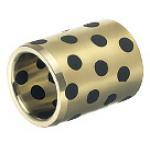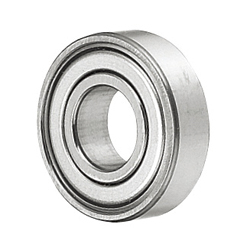Plain bearings in practice: selection and assembly
Plain bearings are a type of bearing used in machines to facilitate the movement of shaft and bearing. They are also referred to as plain shells, plain bearing bushes, plain bearing sleeves or plain bearing sheaths. Plain bearings are usually made of metal, plastic or ceramic. They are an important component of many machines because they reduce friction between shaft and bearing, thus extending the service life of the machine.
What are plain bearings used for?
Due to their robustness, plain bearings are used in almost all industrial sectors.
Plain bearing bushings are used in various machines as radial bearings or axial bearings. In addition to plain bearing bushings, plain bearings are also commonly known as sliding strips, plain bearing strips or plain bearing plates.
The sliding movement occurs when the surfaces of the bearing and the mounted component slide past one another.
Regularly maintained and lubricated, or even self-lubricating, plain bearings enable low-friction movement between components such as: shaft and bearings, thereby extending the lifetime of the machine.
Compared to rolling bearings, plain bearing bushes require less space and can often accommodate a higher load due to the larger contact surfaces compared to rolling bearings.

What are the properties of plain bearings and how are they used?
Plain bearings are, among other things, also known as plain bearing bushes, are an important component in mechanical systems. They provide a low-friction connection between moving parts and help to reduce wear and noise. The most important properties of plain bearings are:
- Low friction: The main advantage of plain bearings is their capability to reduce friction. This means greater efficiency and reduced wear.
- Low maintenance: Plain bearings are often made from materials that have natural lubrication and thus minimise maintenance. Alternatively, solid lubricants such as graphite are incorporated into the plain bearing recesses, ensuring continuous lubrication. In some cases, additional lubricants may be used to further reduce wear.
- Low noise: Due to their sliding contact surfaces, plain bearings also contribute to noise reduction caused by moving parts.
- High resilience: Plain bearings can carry large forces and loads without compromising their performance.
- Space-saving: Due to their low wall thickness, plain bearings require little space during installation and can also be used in applications where space is limited.
Plain bearings are used in a variety of industrial applications, from small electromechanical systems to large industrial plants. They are ideal for applications where high loads occur and low maintenance costs are to be achieved.
What is the difference between plain bearings and rolling bearings?
Plain bearings are components in which a movable component, e. g. a movable shaft slides in direct contact on the bearing surface. The friction between the shaft and the bearing surface is reduced by lubricants supplied either firmly embedded in the plain bearing bush or by an external lubrication system. High loads can be absorbed by evenly distributing the forces acting on the bearing surface. Plain bearings are often used in applications where high loads and low speeds occur.
In rolling bearings, however, balls or rollers serve as contact points. The contact between the balls or rollers and the moving components is point-shaped and generates less friction than with plain bearings. This enables rolling bearings to achieve higher speeds, meaning that they are particularly suitable for applications with medium to high loads and high speeds.
| Storage type | Plain bearing | Roller bearing | Roller bearing |
|---|---|---|---|
| Example illustration |  |
 |
 |
| Lubrication | Self-lubricating | Lubrication required | Lubrication required |
| Linear tables | suitable | well suitable | unsuitable |
| Rotational movement | suitable | unsuitable | well suitable |
| Load-carrying capacity | well suitable | unsuitable | suitable |
| Heat resistance | well suitable | unsuitable | unsuitable |
| Corrosion resistance | suitable | unsuitable | unsuitable |
| Wear resistance | poor | well suitable | well suitable |
| Space requirements | low | high | high |
What types of plain bearing bushes are there?
There are many different types of plain bearings with their specific properties. Plain bearings can be used in a variety of materials (e.g. copper bearings, sintered bronze bearings, plastic bearings) and molds (cylinder bearings, flange or collar bearings).
| Design | Properties | Shape design |
|---|---|---|
| Copper alloy (metal version) | - High temperature resistance - High corrosion resistance - Excellent impact resistance - Ideal for high loads and low speeds of rotation |
- Straight - With collar - Axial design (integrated thrust disc) - Flange housing - Block housing |
| Sintered bronze | - Resistant to friction welding - Short movements are possible - Ideal for applications with low load and high speed of rotation |
- Straight - With collar - With flange |
| Cast steel | - Ideal for applications with medium load and low speed of rotation | - Straight - With collar - With housing |
| Multi-coating | - High temperature resistance - Ideal for applications with high load and low speed of rotation - Thin-walled and compact |
- Straight - With collar - With housing |
| Plastic | - High temperature resistance (PTFE) - Excellent chemical resistance (PTFE) - Ideal for applications with low load and high speed of rotation |
- Straight - With collar |
How do self-lubricating plain bearings work?
Self-lubricating plain bearings (including self-lubricating bushings) are special bearing components that enable continuous lubrication and do not require additional lubricants. What is special is that they are made of a material that already contains a lubricant source and releases it during movement.
The lubricant source can be, for example, a reservoir embedded in the pores of the material (oil-soaked sintered metal bearings) or also a solid lubricant (graphite) inserted into the recesses of the bearing. The lubricant is released by pressure and friction between the sliding surfaces between bearing surface and shaft. This results in a thin lubricating film that reduces friction and prevents excessive wear.
Self-lubricating plain bearings have a longer service life, lower maintenance costs and a higher load capacity than conventional bearings. When selecting the right bush, it is important to consider the specific requirements of the application and to carry out a thorough consideration of the operating conditions.
How are plain bearings mounted?
Correct assembly of plain bearings is decisive to ensure secure fastening and optimum performance. The hardness of the shaft and bearing should generally have a significant difference, so that wear occurs predominantly on the bearing, as it is easier to replace. Ideally, the shaft is made of hardened material. Incorrect assembly or material pairing can cause damage and impair the service life of the components.
Before the actual assembly, all components must be thoroughly cleaned to remove foreign particles and prevent damage to the running surfaces. It must also be ensured that the shaft and the housing are free of damage and burrs.
Pressing in
When pressing in cylinder and flange bushings, the plain bearing is pressed into a housing using aids such as vises or other pressing devices (press fit). Particular attention must be paid to the dimensions and tolerances in order to ensure precise pressing.
To facilitate the press-in process, the housing bores are chamfered and provided with a thin film of lubricating grease or lubricating oil. A fitting mandrel can be used to guide the plain bearing during pressing in and to prevent tilting.

- (1)- Opening
- (2)- Plain bearings
- (3)- Housing
Turning Stop Screw
In order to secure the plain bearing against rotation in its housing, rotation stop screws can be used (press fit/transition fit). This mounting method is recommended for applications where high loads, high rotation speeds or high temperatures are expected.

- (1)- Rotary stop screw
Gluing in
If the use of a rotary stop screw is not possible for certain reasons, the plain bearing can be attached to the housing with adhesive (clearance fit).
It must be noted that the adhesive used withstands the operating conditions, in particular with regard to the operating temperature that occurs. For applications that require a high degree of precision, this assembly method is not recommended due to positioning inaccuracy.

- (1)- Plain bearings
- (2)- Adhesive
What standards does MISUMI use?
Different standards are used for plain bearings in different standardization areas around the world. As part of the international harmonization of standards, international standards are gradually being introduced.
MISUMI, as an international supplier of configurable mechanical components, manufactures plain bearings and plain bearing bushings in various shapes and designs. The manufacturing and installation tolerances of the ISO tolerance.
In Germany, plain bearings are covered by the basic standard DIN 1850 (Parts 1 to 6). These define the dimensions and technical requirements for plain bearings made of different materials. These requirements include e. g. the materials themselves, the size, shape, surface texture, accuracy and dielectric strength.
When selecting plain bearing bushings, it is important to know the exact specifications of the application, all components involved, ambient conditions and materials and to take these into account when making the selection.
Some of the standards used in Germany for plain bearings are:
- ISO 4379:1995-10 - Plain bearings - Bushings made of copper alloys treated (formerly DIN 1850-1)
- ISO 12128:1998-07 - Plain bearings - Lubrication holes, lubrication grooves and lubrication pockets - Dimensions, shapes, designation and their application for bearing bushes (formerly DIN 1850-2)
- DIN1850-3 :1998-07 - Plain bearings - Part 3: Sintered metal bushings
- DIN1850-4:1998-07 - Plain bearings - Part 4: Bushings made of artificial carbon
- DIN1850-5:1998-07 - Plain bearings - Part 5: Thermoset bushings
- DIN1850-6:1998-07 - Plain bearings - Part 6: Thermoplastic bushings



